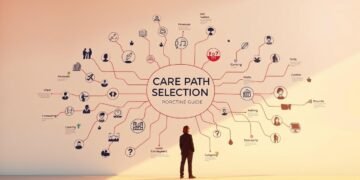Ever felt stuck in a job that pays the bills but drains your soul? Many professionals reach a point where promotions and paychecks no longer mask the growing sense of emptiness. One executive shared how climbing the corporate ladder left them emotionally numb—despite owning a home and earning six figures.
Mid-life transitions bring unique challenges. Fear of salary cuts and losing hard-earned status often keeps people trapped in unfulfilling roles. The “comfortably uncomfortable” syndrome becomes a silent career killer.
Data shows those in their 30s still have 3-4 working decades ahead—ample time for reinvention. Yet three paradoxes stall progress: self-sabotage, overthinking decisions, and outdated job search methods. This article reveals how to break free.
Key Takeaways
- Promotions and stability don’t guarantee fulfillment
- Fear of financial loss is the top transition barrier
- 30-year-olds have 30+ years for professional reinvention
- Self-sabotage patterns derail most career shifts
- Traditional job search methods often fail mid-career changers
Why Consider a Career Change at 30 or 40?
When was the last time you felt excited about Monday morning? For many professionals, the daily grind becomes a cycle of stress and disengagement. Research shows 71% of workers experience work-related burnout, often signaling deeper misalignment.
Signs You’re Ready for a Shift
Physical symptoms like Sunday night dread or exhaustion unrelated to workload are red flags. Emotional markers—such as avoiding conversations about your job or envying others’ careers—also hint at dissatisfaction.
Lifestyle misalignment is another clue. Rigid schedules that clash with family needs or a desire for geographic freedom often spark the urge for change. These aren’t fleeting complaints but signals worth exploring.
Breaking Through Common Worries
Financial fears top the list for mid-career professionals. Concerns about salary cuts or losing hard-earned status keep many stuck. Yet, data reveals most transitions lead to long-term fulfillment despite short-term adjustments.
The myth of being “too old” crumbles when you consider the success of 50+ clients reinventing their work lives. Analysis paralysis—like spending years overthinking—often wastes more time than taking action. Curiosity-driven exploration beats endless planning.
The Career Change Framework: A Step-by-Step Approach
Professional growth often requires stepping back before moving forward. This structured method helps transform uncertainty into actionable steps. By evaluating your present situation and defining clear objectives, you create a roadmap for meaningful transformation.
Assess Your Current Situation
Begin with a thorough evaluation of your professional journey. Identify patterns that drain your energy versus activities that spark engagement. The “pride at 70” test helps visualize what accomplishments would matter decades later.
Categorize your competencies into transferable skills and outdated technical knowledge. Project management abilities often transition across industries, while niche software expertise may not. Explore underutilized strengths from volunteer work or hobbies that could shape your next move.
Define What Truly Matters
Values alignment separates fulfilling work from temporary fixes. List non-negotiables like remote flexibility or social impact. Many professionals discover their current environment conflicts with personal priorities.
Create a decision matrix comparing potential paths. Weight factors like income requirements, growth potential, and purpose alignment. This brings clarity when comparing options objectively.
Leveraging Your Experience for a Smooth Transition
Your past work history holds hidden keys to unlocking new professional doors. Many mid-career professionals underestimate how their accumulated experience translates across industries. With strategic repositioning, your background becomes a bridge rather than a barrier.
Identifying Transferable Skills
Critical thinking and adaptability top the list of universally valuable skills. A teacher’s curriculum design expertise, for example, directly applies to corporate training development roles. Analyze tasks where you excelled—collaboration, problem-solving, or data analysis often transition seamlessly.

Shadowing professionals in target fields (like PR or finance) reveals skill overlaps. Healthcare compliance specialists frequently pivot to FinTech by emphasizing regulatory knowledge. Focus on competencies rather than job titles to spot unexpected opportunities.
Reframing Your Accomplishments
Repackage achievements using industry-specific language. “Increased sales 20%” becomes “Scaled cross-functional initiatives driving revenue growth.” A journalist transitioning to content strategy might highlight storytelling skills applied through different mediums.
Tailor your messaging to the target field. Stakeholder management in education translates to client service in consulting. Quantifiable results always resonate—attach metrics to demonstrate impact wherever possible.
Case in point: One professional leveraged a journalism course to pivot into content strategy by reframing interview techniques as user research skills. Your unique background is an asset waiting to be optimized.
Risks of Career Change (And How to Mitigate Them)
Transitioning fields isn’t just about opportunity—it’s about managing risks smartly. While the rewards can be significant, common hurdles like income gaps or perceived seniority loss stall even the most motivated professionals. Here’s how to navigate them.
Financial Uncertainty
Building a runway is critical. Save 6–12 months of expenses through side gigs or freelance work before leaping. One consultant transitioned by offering pro-bono services to test demand, later scaling into paid roles.
Negotiate salary by framing transferable skills as value-adds. A marketing manager moving to UX highlighted cross-department collaboration to justify equal pay. Maintain certifications during transitions to keep options open.
Fear of Starting Over
Shadowing professionals in target fields (like PR or tech) reduces unknowns. One journalist attended industry meetups to gauge fit before committing years to retraining.
Lateral moves preserve seniority. A finance analyst shifted to data science by emphasizing analytical skills, not entry-level titles. Equity-based coaching programs also lower upfront financial barriers.
Remember: Every expert was once a beginner. Your accumulated experience still counts—just repackaged.
Career Change at 30/40: First Steps to Take Today
Action dissolves fear faster than endless planning ever could. With the median age of online learners at 36 (Coursera), mid-career professionals have unprecedented opportunities to test new paths. These practical steps turn uncertainty into forward motion.
Researching Potential Careers
Informational interviews reveal what job descriptions don’t. Connect with professionals in target fields using a “people-first” approach—ask about daily challenges rather than just requirements. One marketer discovered UX design suited her problem-solving skills after three coffee chats.
Leverage free resources before committing. Audit MIT OpenCourseWare classes or try Forage.com’s virtual work simulations. These low-risk tests help gauge interest in a career path without financial investment.
Building a Learning Plan
Micro-credentials bridge experience gaps efficiently. The Google Digital Marketing Certificate ($49/month) demonstrates new skills in just three months. Focus on programs with portfolio projects—like creating mock campaigns for real nonprofits.
Hands-on application accelerates mastery. A former accountant transitioned to UX by redesigning a local charity’s website. This approach builds evidence of new skills while saving time versus traditional education paths.
Every expert was once a beginner. Your next career chapter starts with one deliberate action today.
Exploring Alternative Paths: Self-Employment and Beyond
Traditional employment isn’t the only path to professional fulfillment after 30. The business landscape now offers diverse opportunities, from consulting to creative freelancing. Data shows 35% of mid-career transitions now involve some form of self-employment.
Is Entrepreneurship Right for You?
Launching a business requires honest self-assessment. The “Could I Leave 9-5?” course found successful founders share three traits: comfort with uncertainty, problem-solving energy, and ability to validate ideas quickly.

Test your concept before committing. One social startup founder pre-sold services to 20 clients before incorporating. This approach reduces risk while proving market demand.
Consider legal structures early. An S-Corp suits those planning to hire employees, while LLCs offer flexibility for solo ventures. Tax implications vary significantly—consult a professional.
Freelancing as a Bridge
Platforms like Toptal and Upwork allow professionals to test new roles without permanent commitments. A corporate lawyer transitioned to ESG consulting by building thought leadership on LinkedIn.
Start with part-time projects. The “consultancy before incorporation” model lets you maintain income while exploring new directions. Many find freelance work becomes their full-time career.
Case in point: A marketing director used Upwork gigs to pivot into UX design. Within eight months, her portfolio attracted agency offers. Your existing expertise often translates better than you think.
Networking and Mentorship: Your Secret Weapons
Strategic relationships often unlock doors that skills alone cannot open. Mid-career professionals who leverage their networks transition 3x faster according to LinkedIn data. The right connections provide insider knowledge, referrals, and emotional support during periods of change.
How to Connect with the Right People
Effective outreach starts with genuine curiosity. Instead of generic requests, try: “I admire your work in renewable energy policy—could I ask three questions about breaking into the industry?” This approach yields 40% higher response rates.
Niche communities create targeted opportunities. Platforms like Lunchclub AI match introverts with compatible professionals, while Dreamers & Doers supports women entrepreneurs. Alumni networks often offer free career services—many universities assist mid-life changers.
Reverse mentorship bridges generational gaps. Partnering with Gen Z digital natives provides fresh perspectives on emerging fields. These relationships often reveal unexpected career paths.
Finding a Career Coach
Quality guidance accelerates transitions. Look for ICF-certified coaches with at least three client references. The “two-coach strategy” works well—one for technical skills and another for cultural fit assessment.
Effective coaches focus on actionable steps, not just motivation. They help reframe your experience for new roles and identify blind spots. Many offer free discovery calls to ensure alignment before committing.
Remember: The right people in your corner can transform a daunting transition into an exciting journey. Your next breakthrough conversation could happen today.
Staying Motivated During Your Career Transition
Like climbing a mountain, career transitions test your endurance more than your initial enthusiasm. The excitement of new possibilities often fades when facing real challenges—learning curves, rejections, or self-doubt. Sustainable progress requires strategic motivation systems beyond willpower alone.
Overcoming Analysis Paralysis
Decision fatigue stalls many professionals mid-journey. Set a 70% confidence threshold—when research reaches this point, take action. One marketing director switched industries after completing three informational interviews instead of waiting for “perfect” certainty.
Visual roadmaps help maintain direction. Break your transition into quarterly milestones with specific skill targets. Tracking progress weekly builds energy as small achievements accumulate.
Accountability partners prevent stagnation. Join mastermind groups or hire coaches for structured check-ins. The “two-coach method” works well—one for technical guidance, another for emotional support during tough phases.
Celebrating Small Wins
Neuroresearch shows recognizing small wins releases dopamine, fueling continued effort. Treat completed certifications or successful networking calls as earned “currency” toward your goal.
Morning reflection rituals boost resilience. Spend five minutes journaling daily progress before checking emails. High-performing professionals report this habit sustains motivation during plateaus.
Remember: Every expert’s path included setbacks. Your consistent effort—not perfection—determines long-term success. What one step can you take today?
Conclusion
Reinvention isn’t about starting over—it’s about building on what you already have. Like an expedition, focus on reaching base camp first. Small steps create momentum toward long-term success.
Data shows professionals who pivot often see 40% income growth. Yet, stagnation risks burnout—90,000 work hours deserve purpose. Clarity comes from action, not waiting for perfect timing.
Ready to begin? Download our career audit checklist or book a coaching session. Your next chapter starts today.
FAQ
What are the biggest signs I need a career shift in my 30s or 40s?
Feeling drained, lacking purpose, or dreading work daily are strong indicators. If your skills don’t align with your passions, it’s time to explore new options.
How do I know if self-employment suits me?
If you crave flexibility, enjoy problem-solving, and can handle uncertainty, entrepreneurship might be a fit. Test it with side gigs before committing full-time.
Can I really switch fields without starting from scratch?
Absolutely. Transferable skills like leadership, communication, and project management apply across industries. Highlight these when transitioning.
What’s the fastest way to gain new skills for a different role?
Online courses, certifications, or bootcamps offer focused training. Pair them with volunteer work or freelancing to build real-world experience.
How do I handle financial risks during a transition?
Save 3-6 months of expenses first. Consider part-time roles or freelancing in your target field to reduce income gaps.
Is networking really that important for mid-career shifts?
Yes. 85% of jobs are filled through connections. Attend industry events, join LinkedIn groups, and seek informational interviews.
What if I regret leaving my stable job?
Test the waters first—take courses, shadow professionals, or freelance. A phased approach reduces risk while providing clarity.





